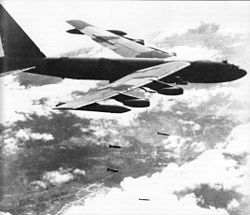
The Ho Chi Minh Trail, also called Annamite Range Trail was a logistical network of roads and trails that ran from North Vietnam to South Vietnam through the kingdoms of Laos and Cambodia. The system provided support, in the form of manpower and materiel, to the Viet Cong and the People's Army of Vietnam (PAVN), during the Vietnam War. Construction for the network began following the North Vietnamese invasion of Laos in July 1959. At the time it was believed to be the main supply route, however it later transpired that the Sihanouk Trail which ran through Cambodia was handling significantly more material.

The Khmer Republic was a Cambodian state under the United States-backed military dictatorship of Marshal Lon Nol from 1970 to 1975. Its establishment was formally declared on 9 October 1970, following the 18 March 1970 coup d'état which saw the overthrow of Norodom Sihanouk's government and the abolition of the Cambodian monarchy.

The Cambodian Civil War was a civil war in Cambodia fought between the forces of the Communist Party of Kampuchea against the government forces of the Kingdom of Cambodia and, after October 1970, the Khmer Republic, which had succeeded the kingdom after a coup.

Operation Commando Hunt was a covert U.S. Seventh Air Force and U.S. Navy Task Force 77 aerial interdiction campaign that took place during the Vietnam War. The operation began on 15 November 1968 and ended on 29 March 1972. The objective of the campaign was to prevent the transit of People's Army of Vietnam (PAVN) personnel and supplies on the logistical corridor known as the Ho Chi Minh Trail that ran from southwestern North Vietnam through the southeastern portion of the Kingdom of Laos and into South Vietnam.
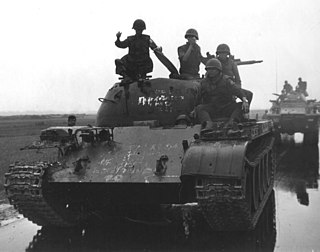
The Easter Offensive, also known as the 1972 spring–summer offensive by North Vietnam, or the Red Fiery Summer as romanticized in South Vietnamese literature, was a military campaign conducted by the People's Army of Vietnam against the Army of the Republic of Vietnam and the United States military between 30 March and 22 October 1972, during the Vietnam War.
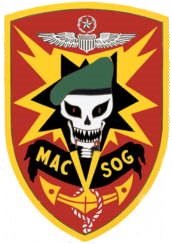
Military Assistance Command, Vietnam – Studies and Observations Group (MACV-SOG) was a highly classified, multi-service United States special operations unit which conducted covert unconventional warfare operations before and during the Vietnam War.
The 1970 Cambodian coup d'état was the removal of the Cambodian Chief of State, Prince Norodom Sihanouk, after a vote in the National Assembly on 18 March 1970. Emergency powers were subsequently invoked by the Prime Minister Lon Nol, who became effective head of state, and led ultimately to the removal of Queen Sisowath Kossamak and the proclamation of the Khmer Republic later that year. It is generally seen as a turning point in the Cambodian Civil War. No longer a monarchy, Cambodia was semi-officially called "État du Cambodge" in the intervening six months after the coup, until the republic was proclaimed.

Operation Menu was a covert United States Strategic Air Command (SAC) tactical bombing campaign conducted in eastern Cambodia from 18 March 1969 to 26 May 1970 as part of both the Vietnam War and the Cambodian Civil War. The targets of these attacks were sanctuaries and base areas of the People's Army of Vietnam and forces of the Viet Cong (VC), which used them for resupply, training, and resting between campaigns across the border in the Republic of Vietnam. The impact of the bombing campaign on the Khmer Rouge guerrillas, the PAVN, and Cambodian civilians in the bombed areas is disputed by historians.

The Khmer National Armed Forces were the official armed defense forces of the Khmer Republic, a short-lived nationalist and militaristic state that existed from 1970 to 1975, known today as Cambodia. The FANK was the successor of the Royal Khmer Armed Forces which had been responsible for the defense of the previous Kingdom of Cambodia since its independence in 1953 from France.

The Cambodian campaign was a series of military operations conducted in eastern Cambodia in mid-1970 by South Vietnam and the United States as an expansion of the Vietnam War and the Cambodian Civil War. Thirteen operations were conducted by the Army of the Republic of Vietnam (ARVN) between April 29 and July 22 and by U.S. forces between May 1 and June 30, 1970.

Operation Lam Son 719 or 9th Route – Southern Laos Campaign was a limited-objective offensive campaign conducted in the southeastern portion of the Kingdom of Laos. The campaign was carried out by the armed forces of South Vietnam between 8 February and 25 March 1971, during the Vietnam War. The United States provided logistical, aerial and artillery support for the operation, but its ground forces were prohibited by law from entering Laotian territory. The objective of the campaign was the disruption of a possible future offensive by the People's Army of Vietnam (PAVN), whose logistical system within Laos was known as the Ho Chi Minh Trail.

Operation Chenla I or Chenla One was a major military operation conducted by the Khmer National Armed Forces (FANK) during the Cambodian Civil War. It began in late August 1970 and ended in February 1971, due to the FANK High Command's decision to withdraw some units from Tang Kauk to protect Phnom Penh after Pochentong airbase was attacked.
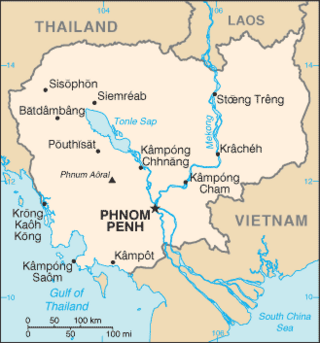
The Sihanouk Trail was a logistical supply system in Cambodia used by the People's Army of Vietnam (PAVN) and its Viet Cong (VC) guerrillas during the Vietnam War (1960–1975). Between 1966 and 1970, this system operated in the same manner and served the same purposes as the much better known Ho Chi Minh trail which ran through the southeastern portion of the Kingdom of Laos. The name is of American derivation, since the North Vietnamese considered the system integral to the supply route mentioned above. U.S. attempts to interdict this system began in 1969.

Central Office for South Vietnam, officially known as the Central Executive Committee of the People's Revolutionary Party from 1962 until its dissolution in 1976, was the American term for the North Vietnamese political and military headquarters inside South Vietnam during the Vietnam War. It was envisaged as being in overall command of the communist effort in the southern half of the Republic of Vietnam, which included the efforts of both People's Army of Vietnam (PAVN), the Viet Cong, and the People's Revolutionary Party. Some doubted its existence but in his memoirs the American commander in South Vietnam, General William Westmoreland, spoke of it as something whose existence and importance were not in doubt.
Operation Freedom Deal was a military campaign led by the United States Seventh Air Force, taking place in Cambodia between 19 May 1970 and 15 August 1973. Part of the larger Vietnam War and the Cambodian Civil War, the goal of the operation was to provide air support and interdiction in the region. Launched by President Richard Nixon as a follow-up to the earlier ground invasion during the Cambodian Campaign, the initial targets of the operation were the base areas and border sanctuaries of the People's Army of Vietnam (PAVN) and the Viet Cong (VC).
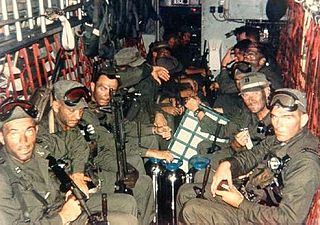
The United States continued its unilateral withdrawal of forces from South Vietnam notwithstanding the lack of progress at the Paris Peace Talks. The removal of Prince Norodom Sihanouk from power in Cambodia in March and his replacement by General Lon Nol, began the Cambodian Civil War. South Vietnamese and U.S. forces entered Cambodia in late April to attack People's Army of Vietnam (PAVN) and Vietcong (VC) bases and supply lines there which had long been used to support the insurgency in South Vietnam. The expansion of the war revitalized the antiwar movement in the U.S. and led to the Kent State shootings and Jackson State killings in May. While U.S. ground forces withdrew from Cambodia at the end of June and legislation was passed to prevent their reintroduction, the South Vietnamese conducted operations in Cambodia for the rest of the year and the U.S. provided air support and military aid to the Cambodian government. Despite this support the Cambodians lost control of vast areas of the country to the PAVN. Within South Vietnam the second half of the year saw a reduction in large U.S. operations with the focus shifting to pacification and population security and supporting Vietnamization. The PAVN/VC generally reverted to sapper attacks and attacks by fire but they fought hard to defend their base areas and infiltration routes.

At the start of 1971 South Vietnamese troops continued operations against the North Vietnamese People's Army of Vietnam (PAVN) and Vietcong (VC) base areas in eastern Cambodia. The ill-conceived and poorly executed Operation Lam Son 719 against PAVN supply lines in eastern Laos showed the weaknesses within the South Vietnamese military command and the limited ability of South Vietnam's armed forces to conduct large-scale combined arms operations. The U.S. continued its unilateral withdrawal from South Vietnam despite the lack of any progress in the Paris Peace Talks and by November U.S. forces had ceased offensive operations. The U.S. withdrawal and antiwar sentiment within the military led to an ongoing decline in morale and discipline within the U.S. forces and growing drug use, particularly of heroin. As U.S. combat units withdrew, security in their former operational areas deteriorated and the PAVN/VC began a series of attacks on ARVN positions in Quảng Trị province and the Central Highlands. In Cambodia the Cambodian government continued to lose ground to the PAVN despite extensive U.S. air support and training and periodic attacks into Cambodia by the ARVN. While the bombing of North Vietnam had ceased in November 1968, U.S. aircraft continued to conduct reconnaissance flights over the North and responded to radar-tracking and antiaircraft fire with "protective reaction" strikes which numbered more than 100 by the year-end and culminated in a five-day bombing campaign in late December.

1972 in the Vietnam War saw foreign involvement in South Vietnam slowly declining. Three allies, Australia, New Zealand and Thailand, which had each contributed military contingents, left South Vietnam this year. The United States continued to participate in combat, primarily with air power to assist the South Vietnamese, while negotiators in Paris tried to hammer out a peace agreement and withdrawal strategy for the United States.
Project Copper was a coordinated military action undertaken by the Kingdom of Laos and the Khmer Republic from 1 January–May 1971. It used U.S. Department of Defense (DOD) funds channeled through the Central Intelligence Agency to train three Cambodian battalions to interdict the Sihanouk Trail before it joined the Ho Chi Minh Trail. Committed to battle in southern Laos on 1 January 1971, one battalion deserted the battlefield, a second one mutinied during training, and a third had to be repurposed after suffering 80 casualties. By late January, the project was temporarily suspended.
